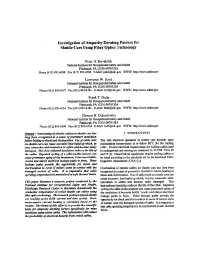Mining Publication: Investigation of Ampacity Derating Factors for Shuttle Cars Using Fiber Optics Technology
Original creation date: October 1997
Overheating of electric cables on shuttle cars has long been recognized as a cause of premature insulation failure leading to shock and electrocution. Use of cable reels on shuttle cars can cause excessive heat build up which, in turn, causes the cable insulation to soften and become easily damaged. This heat-softened insulation reduces the life of the cable. Repeated cycling of a cable in this manner can cause premature aging of the insulation; it becomes brittle, cracks and allows electrical leakage paths to form. These leakage paths provide the opportunity for shock and electrocution to occur if miners come in contact with the damaged section of cable. It is imperative that cable operating temperatures be maintained at safe thermal limits. This paper discusses a research project conducted by the National Institute for Occupational Safety and Health, Pittsburgh Research Center to determine dynamically the conductor temperature of reeled shuttle car cables using fiber optics technology. The research portrays typical shuttle car loading cycles (both current and time cycles). Root-mean-square current loading is calculated based on the results. The thrust of this effort it to provide the scientific basis for ampacity derating factors specifically for mine machinery using reeled cables. This information will reduce the probability of electrical hazards from reeled cables.
Authors: PG Kovalchik, LW Scott, FT Duda, TH Dubaniewicz
Conference Paper - October 1997
NIOSHTIC2 Number: 20000111
IEEE Industry Applications Society 32nd Annual Meeting, Lindsay PA, ed., New Orleans, Louisiana, 1997 Oct; :1-4
See Also
- Derating Factors for Round and Flat Mine Trailing Cables
- Dynamic Temperature Measurement of Overheated Shuttle Car Trailing Cables in Underground Coal Mines
- Electric Shock Prevention
- Heavy Equipment Near Overhead Power Lines? New Safety Research May Save Your Life: New Safety Research May Save Your Life
- Low Temperature Limits for Mixing Recycled Oil, Diesel Fuel, and Ammonium Nitrate to Make ANFO-Type Blasting Agents
- A Performance Evaluation of Two Overhead Power Line Proximity Warning Devices
- Reducing Non-Contact Electric Arc Injuries: An Investigation of Behavioral and Organizational Issues
- Thermal Modeling of Portable Power Cables
- U.S. Bureau of Mines/NIOSH Mining Electrical Safety Research: A Legacy of Protection Against Shock, Fires, and Explosions
- Whole-Body Vibration Exposure Comparison of Seat Designs for Low- and Mid-Seam Shuttle Cars in Underground Coal Mines
- Page last reviewed: 9/21/2012
- Page last updated: 9/21/2012
- Content source: National Institute for Occupational Safety and Health, Mining Program


 ShareCompartir
ShareCompartir
